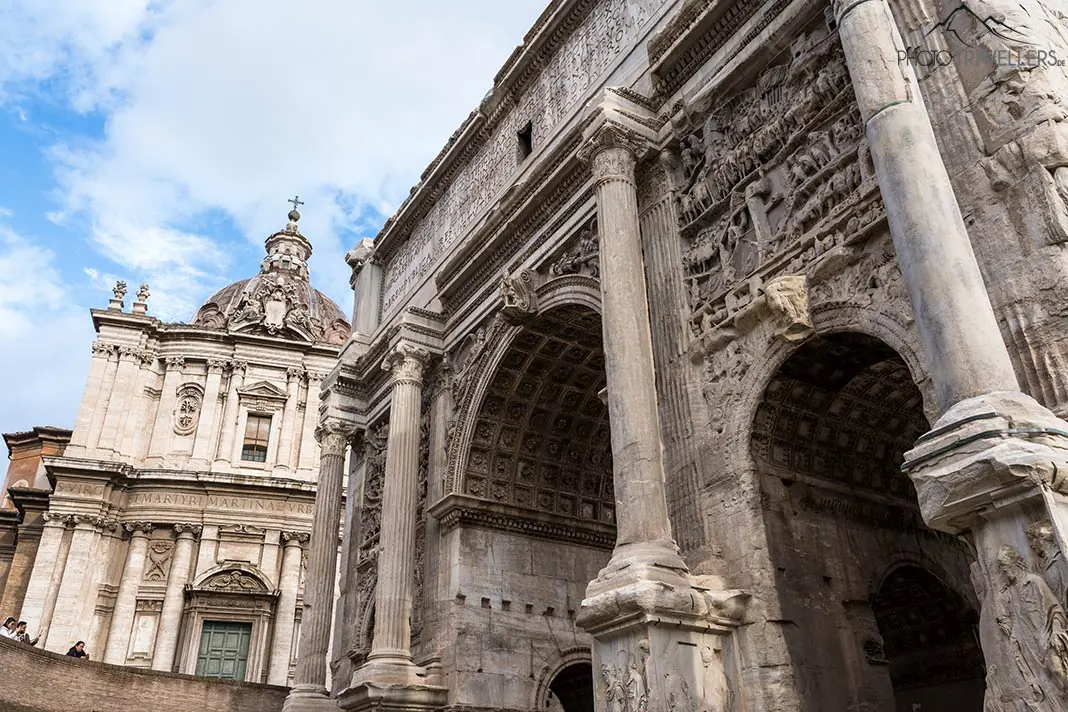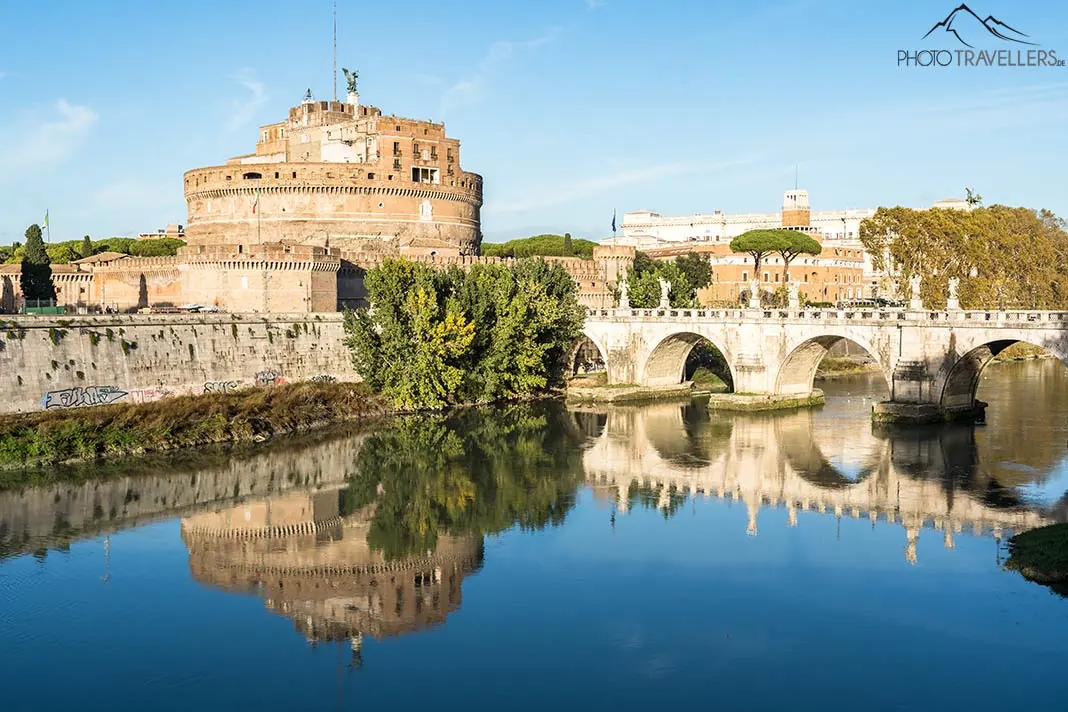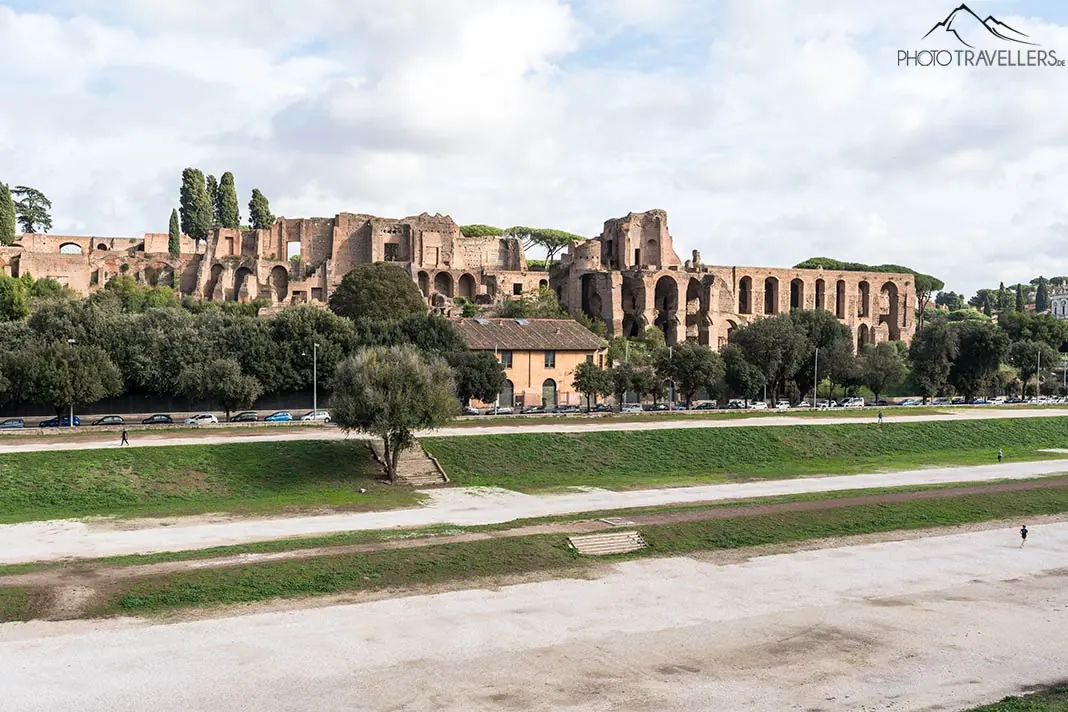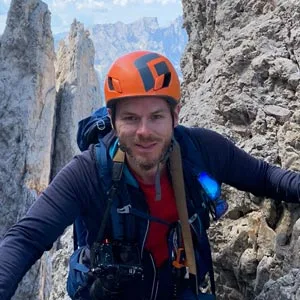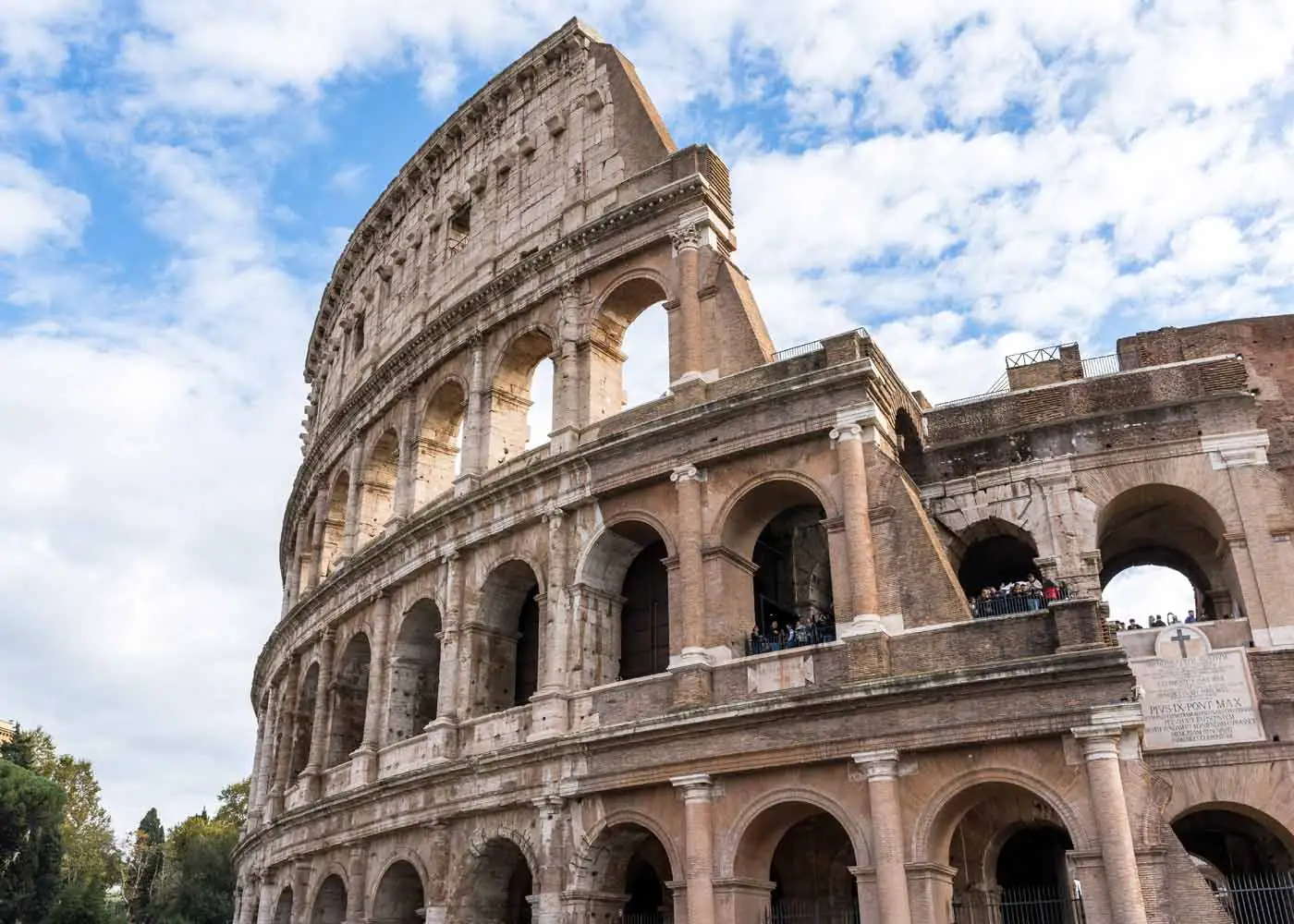
20 best things to do in Rome for 2023
Rome, the "Eternal City", is a living museum, rich in history and art. We stroll with you through streets that are thousands of years old and take you to highlights such as the Colosseum, the Trevi Fountain and St. Peter's Basilica.
Every corner of Rome is a treasure trove of wonders. We show you the most important sights in Rome. Let's uncover the secrets of this historic metropolis together.

Hi! Wir sind Biggi & Flo
Wir nehmen dich als Reisejournalisten mit zu den schönsten Orten der Welt!
Werbehinweis: Alle mit einem * markierten Links sind Werbelinks.
At a glance: What to do in Rome
Colosseum: the largest amphitheater in the world is a must on any trip to Rome
Trevi Fountain: Italy’s most famous fountain is the Instagram motif par excellence
St. Peter’s Basilica: One of the largest churches in the world, absolutely impressive
Vatican Museums: Impressive museum complex, the highlight is the Sistine Chapel
That was just a small taste of what awaits you in Rome. You can easily explore the city on foot or by bus and train. We recommend planning at least three to four days for Rome. At the end of the article you will find our interactive map with an overview of all the sights in Rome.
Here you can find our travel tips for Rome with children.
1. Colosseum
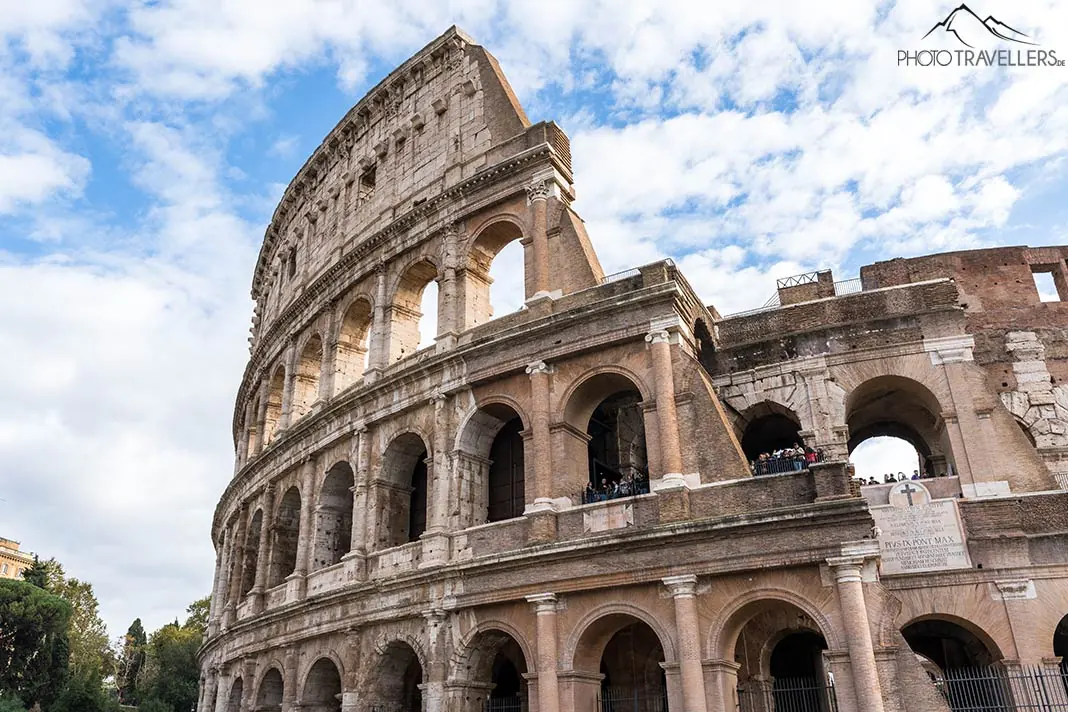 Even from the outside, the Colosseum is simply imposing
Even from the outside, the Colosseum is simply imposing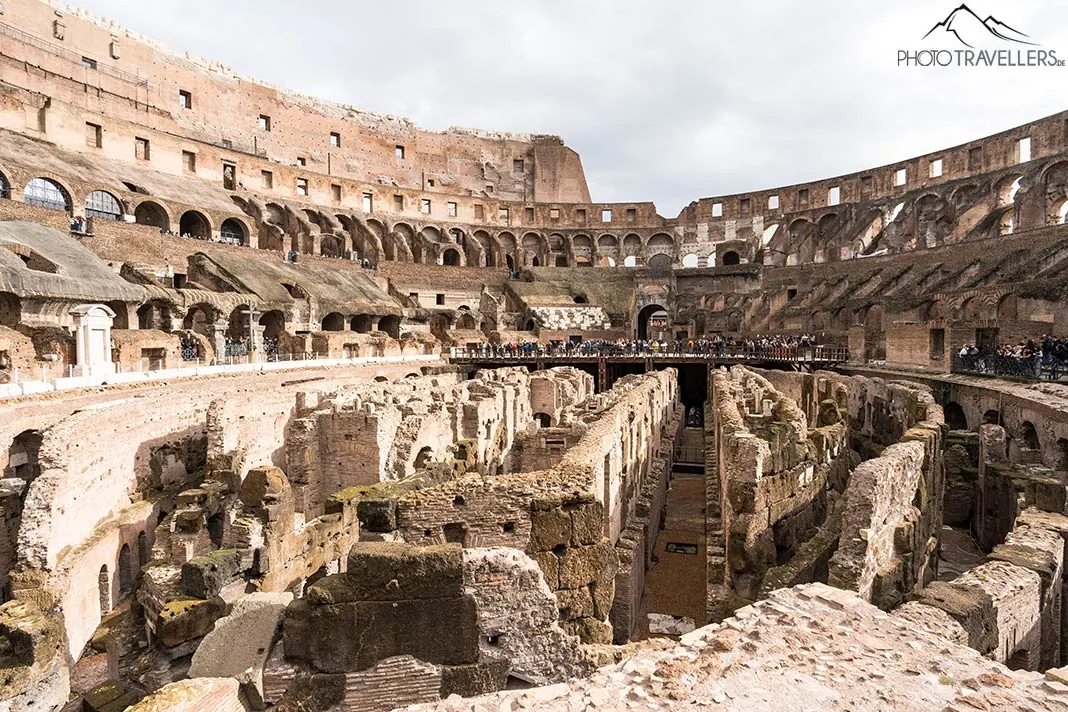 Brutal gladiator fights once took place in the arena
Brutal gladiator fights once took place in the arenaWe start with the landmark of the Italian capital: the Colosseum. The largest amphitheater in the world was far ahead of its time in terms of architecture and technology. The imposing building was constructed in just eight years between 72 and 80 AD! Even today, modern arenas and stadiums are modeled on the Colosseum. Crazy, isn’t it?
If the Colosseum impresses you from the outside, your jaw will drop inside. The amphitheater once hosted brutal gladiator fights and animal fights for the amusement of the “free inhabitants of Rome”. Some historians estimate that up to 500,000 people lost their lives in the arena (others consider this estimate to be completely exaggerated). Either way, this knowledge gives you goosebumps when you enter the amphitheater
The bloody spectacle was once cheered on by 50,000 spectators in the arena (other estimates put the figure at almost 90,000). From the upper floor you have a great view over the arena. Take some time and transport yourself back to Roman times.
Tip: Look out for the imposing Arch of Constantine (Arco di Costantino) in front of the Colosseum, a huge Roman triumphal arch dating back to 315.
Make sure you get your tickets for the Colosseum in advance! Otherwise, you can expect to wait a few hours at the checkout. Admission to the Colosseum also includes admission to the Roman Forum and the Palatine Hill (our number 5 attraction). If tickets are sold out on the official website, you still have a good chance on GetYourGuide*. If you are between 18 and 25 years old, you can get many tickets for the price of two euros – for example to the Colosseum, the Galleria Borghese or Castel Sant’Angelo.
Good to know: You will discover the initials “SPQR” on numerous statues and monuments, as well as manhole covers and garbage cans. This stands for “Senatus Populusque Romanus”, the Latin motto of the city, which translates as “Senate and People of Rome”
2. Trevi Fountain
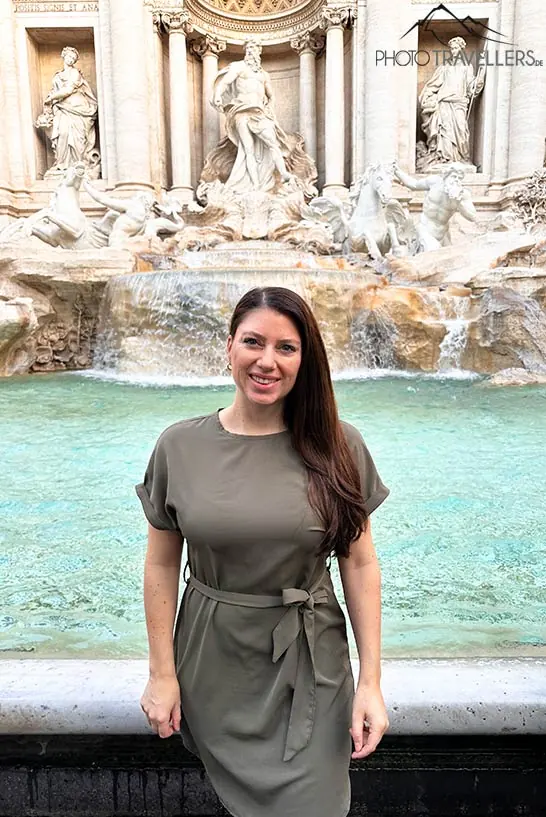
Everyone wants a photo in front of the Trevi Fountain
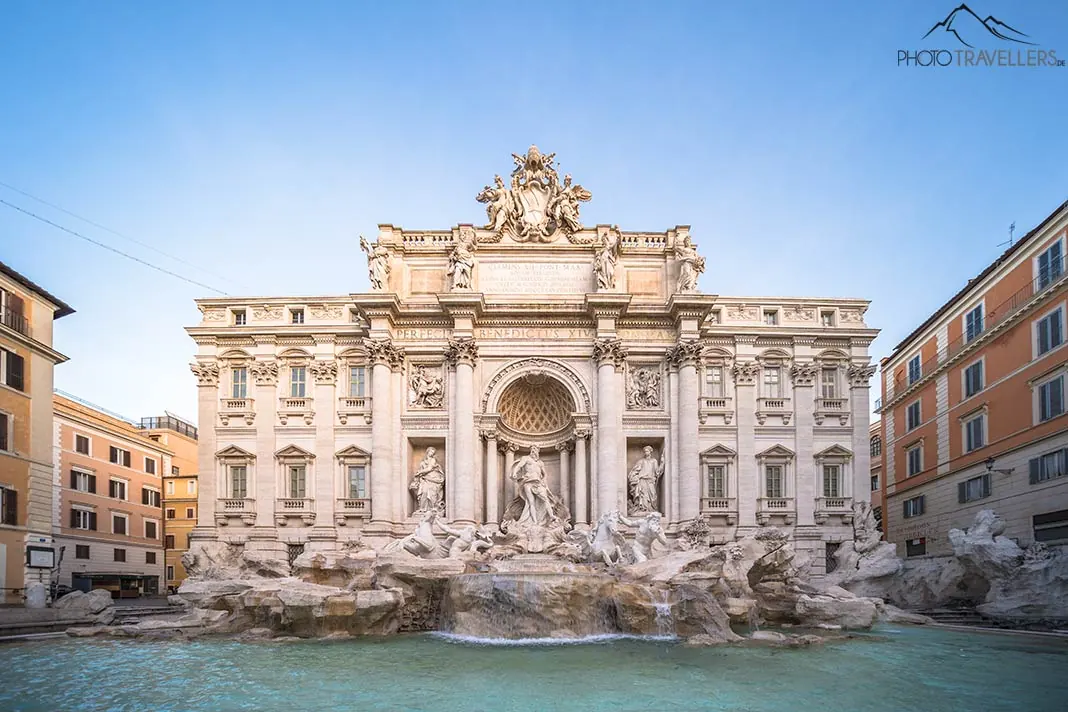
The fountain is one of the top highlights of the Eternal City
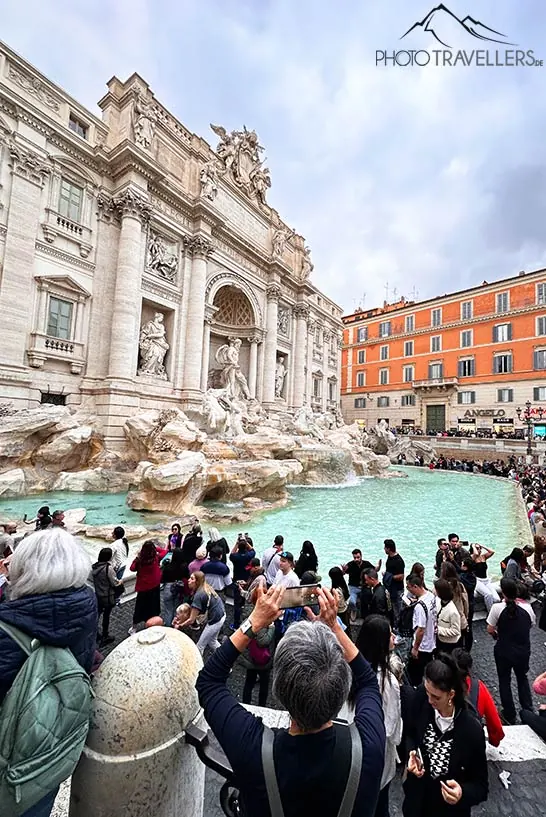
But that’s also part of the truth: it’s actually always crowded at the Trevi Fountain
The next highlight takes us deep into the ancient heart of the city, more precisely to the imposing Trevi Fountain. The “Fontana di Trevi”, which presumably goes back to the three springs – i.e. “tre vie” – is the only aqueduct that has been in continuous operation since ancient times.
The most famous fountain in Italy, which adjoins a wall of the Palazzo Poli, is extremely impressive at 26 meters high and 50 meters wide. Everyone really wants to take a photo here. We have never experienced a place in Rome that is so crowded – all day long. Even very early in the morning, there are already plenty of people here to take the perfect picture of themselves with the Trevi Fountain.
Incidentally, it is traditional to throw a coin into the fountain with your left hand over your right shoulder with your back to the fountain. It makes a difference whether you toss one, two or three coins – in this order, this means you return to Rome, fall in love with a Roman or even marry this person.
3. St. Peter’s Basilica and St. Peter’s Square
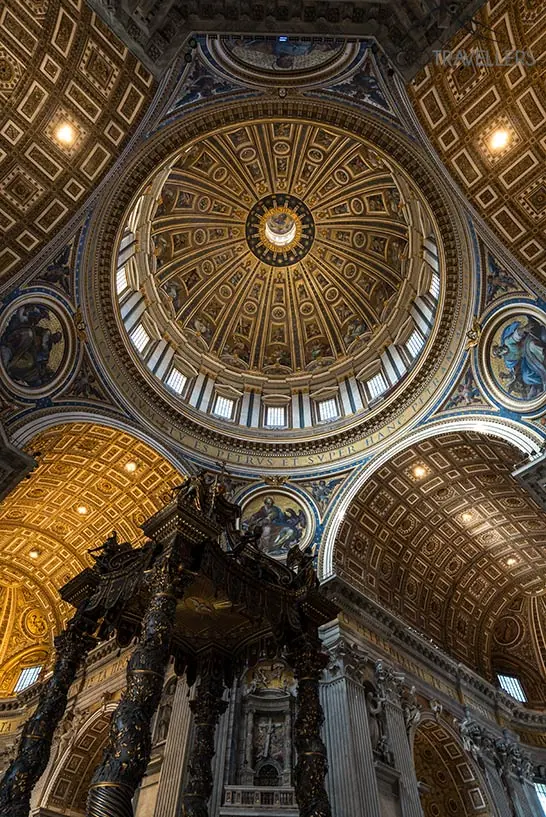 This is the view upwards into the imposing dome of St. Peter’s Basilica
This is the view upwards into the imposing dome of St. Peter’s Basilica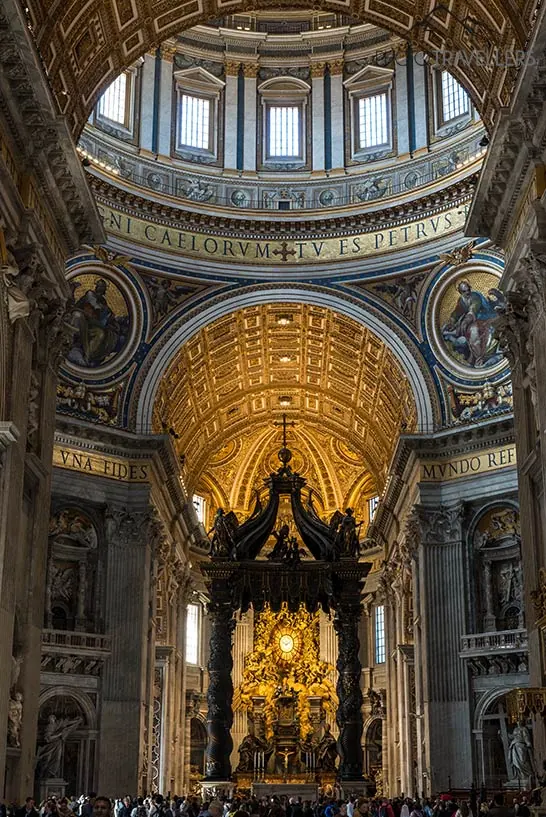 The canopy ciborium measures almost 29 meters – that’s nine storeys!
The canopy ciborium measures almost 29 meters – that’s nine storeys!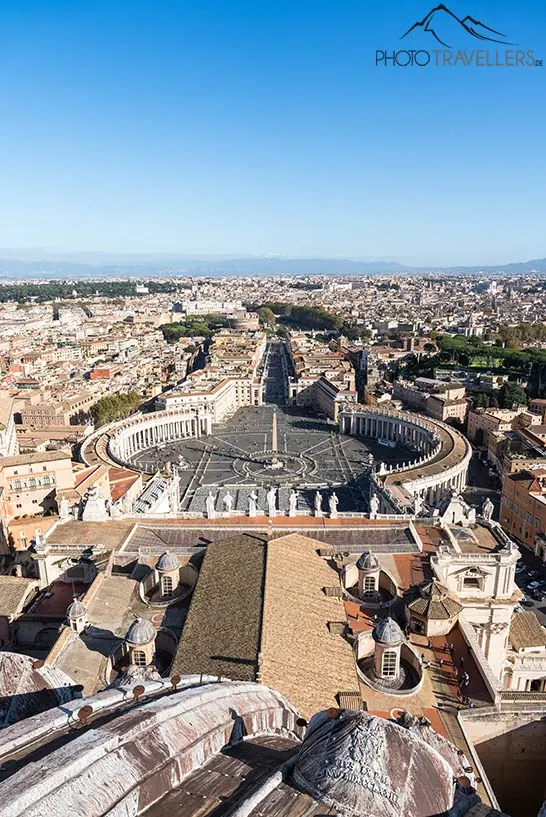 This is the view from the dome of St. Peter’s Basilica to St. Peter’s Square
This is the view from the dome of St. Peter’s Basilica to St. Peter’s SquareOf course, a trip to Rome must include a detour to Vatican City, the smallest state in the world with an area of 44 hectares and the Pope’s seat of government. The highlight is the imposing St. Peter’s Basilica (Basilica of St. Peter in the Vatican), the largest of the papal basilicas and one of the largest churches in the world.
To even begin to grasp the true size of the cathedral, you’ll find star-shaped markings on the floor of the nave that show the dimensions of 31 other large churches around the world.
Admission to St. Peter’s Basilica is free of charge. However, if you don’t arrive early in the morning, you can expect a long queue in front of the cathedral. Every visitor is subjected to a thorough check, just like at the airport. Appropriate clothing is also mandatory.
We have already seen many churches, but St. Peter’s Basilica remains unforgettable. The huge church is richly decorated and extremely imposing. The view up into the dome will leave you speechless.
A visit to the Vatican Grottoes below the cathedral is also a must. The crypt is the resting place of 24 of 265 deceased popes, as well as the German Emperor Otto II († 983).
If you visit St. Peter’s Basilica, you will inevitably come to St. Peter’s Square. The symmetrical square surrounded by colonnades with the Vatican obelisk in the middle is the venue for the Pope’s general audience, which – weather permitting – is held there every Wednesday.
Tip 1: The climb up to the dome of St. Peter’s Basilica is absolutely worthwhile. Halfway up, you have a great view of the dome from above. From here, continue up to the dome, from where you can enjoy a fantastic view of St. Peter’s Square and the whole of Rome. However, the waiting time at the ticket office (8 euros admission, 10 euros with elevator) can be very long.
Tip 2: One of the best views of St. Peter’s Basilica, especially at sunset, is from the rooftop bar in the Atlante Star Hotel in Via dei Bastion (Google Maps).
4. Vatican Museums with Sistine Chapel
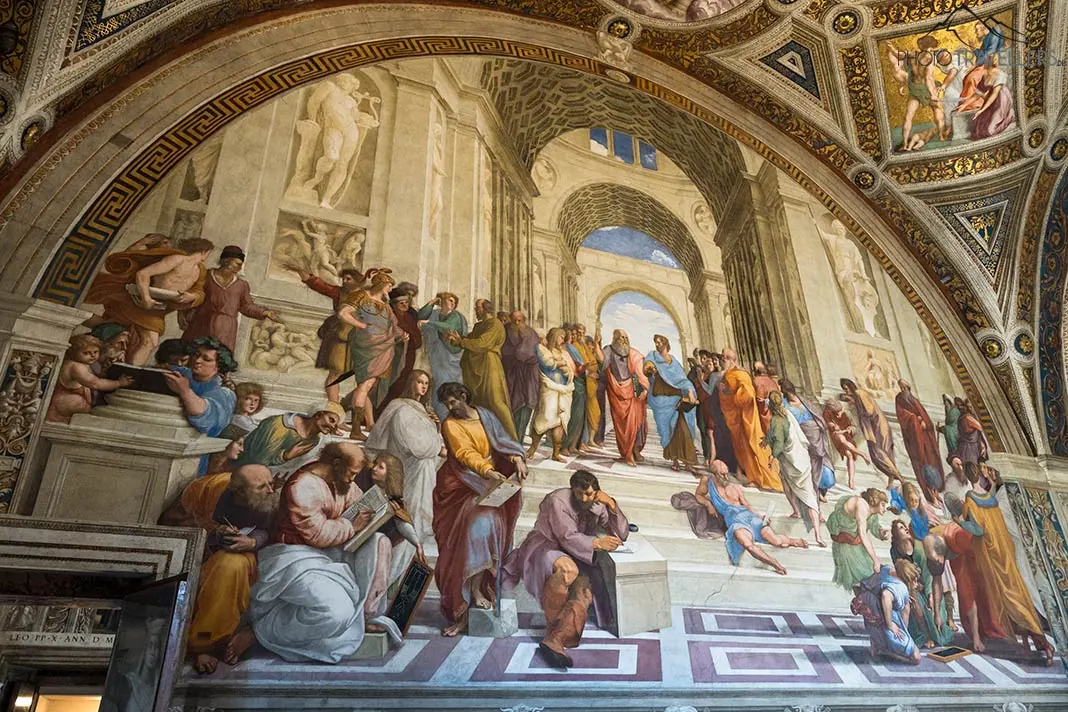 The famous fresco “The School of Athens” in the Stanza della Segnatura
The famous fresco “The School of Athens” in the Stanza della Segnatura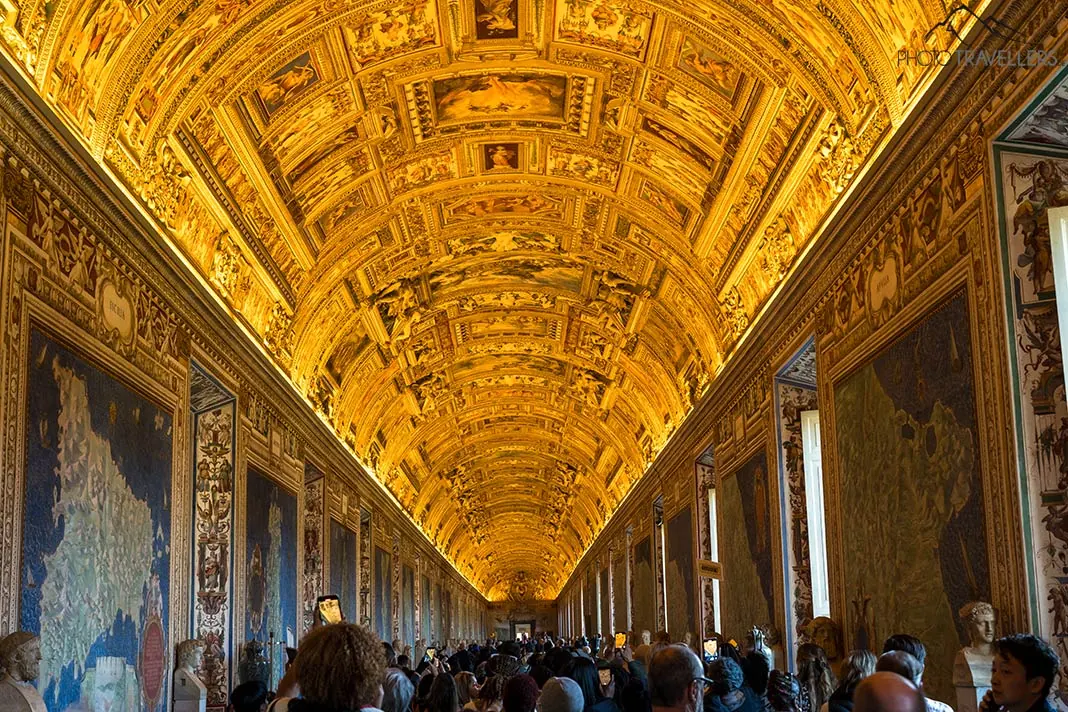 The 120-meter-long “Gallery of Maps” features 40 large maps of various regions in Italy
The 120-meter-long “Gallery of Maps” features 40 large maps of various regions in ItalyAnother “must see” is the Vatican Museums. The rooms with their many paintings and statues are extremely impressive. The many highlights include the Raphael’s stamps (these are rooms in the Apostolic Palace painted by Raphael and his school), the Gallery of maps and of course the Sistine Chapel (unfortunately no photos and videos are allowed here) with the famous fresco by Michelangelo depicting the Creation of Adam shows. However, the ceiling painting is much smaller than we had imagined.
Another popular photo motif is the spiral staircase designed by Guiseppe Momo in 1932, which you reach shortly before the exit after visiting the Sistine Chapel.
However, an incredible number of people crowd through the museum rooms. Unfortunately, this ruins the experience a little. This is just for information. But don’t let this put you off! Even on a quick tour, you’ll easily need two hours to visit the Vatican Museums. But you can easily spend a whole day here.
You should definitely buy your tickets for the Vatican Museums online well in advance. You can wait up to three hours at the cash desks on site without booking online!
5. Roman Forum and Palatine Hill
The Palatine Hill is located very close to the Colosseum. This is one of the seven hills on which ancient Rome was built. Today, there is an extensive archaeological park here with lots to discover. You also have a beautiful view of the famous Roman Forum from the viewing terrace on the Palatine Hill.
Forum Romanum can be translated as“Roman marketplace“. The Forum Romanum was the center of the city’s political, economic, cultural and religious life from the 6th century BC.
You should allow at least three hours to explore the whole area. Highlights include the Titus Arch (Arco di Tito) from the 1st century, the Temple of Venus and Roma (Tempio di Venere e Roma; here you have the best view of the Colosseum), the Temple of Antoninus Pius and Faustina (Tempio di Antonino e Faustina) and the Arch of Septimius Severus (Arco di Settimio Severo).
Admission to the Roman Forum and Palatine Hill also includes admission to the Colosseum and vice versa. As already mentioned, you should definitely buy your ticket online in advance!
Incidentally, the Roman Forum is easy to see from the outside. However, we strongly recommend that you explore the area in more detail. You can get the famous view of the Roman Forum for free from the Terrazza sul Foro in Via Monte Tarpeo (Google Maps).
6. Spanish Steps
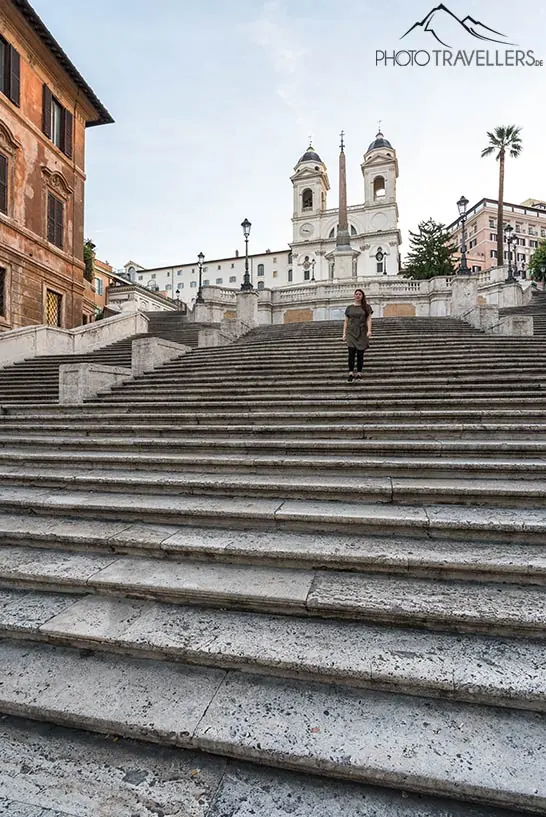
The Spanish Steps are only this empty early in the morning
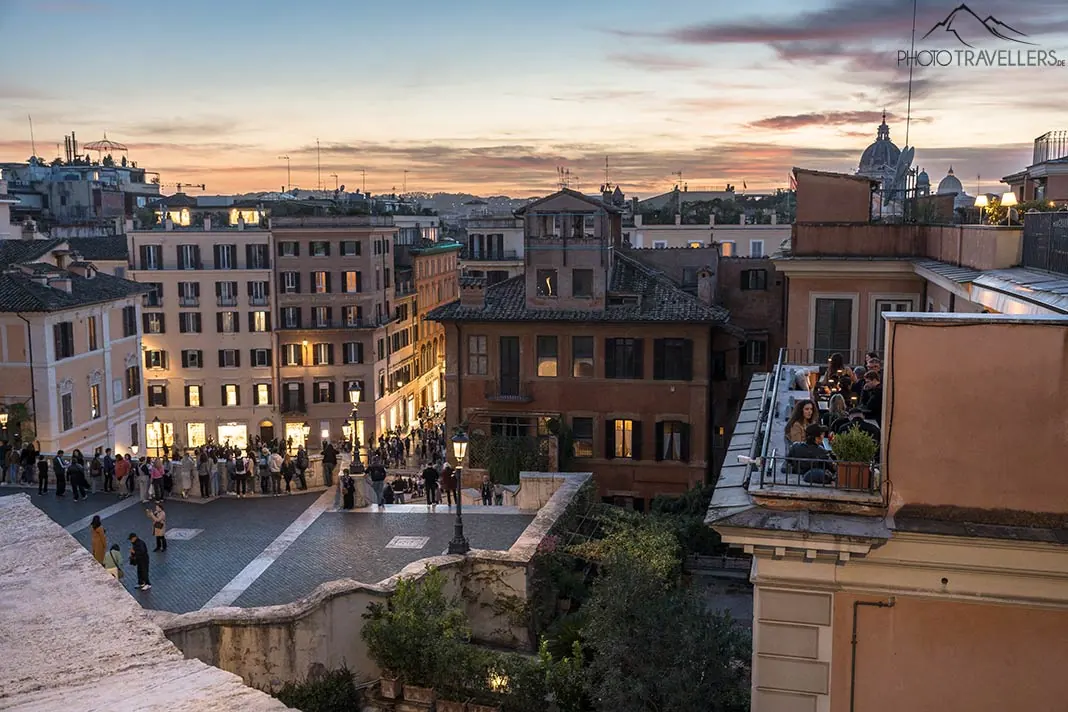
In the evening, the Spanish Steps are a popular meeting place
What else should you definitely not miss on a trip to Rome? The Spanish Steps, of course, one of the most famous staircases in the world.
The staircase, built at the beginning of the 18th century, leads up 136 steps to the Obelisco Sallustiano and the Trinità dei Monti, a 16th century church. From the upper terrace, the Piazza della Trinità dei Monti, you have a great view over the Spanish Steps and the old town. There is also an (expensive) Skybar with a view of the Spanish Steps. Oh yes, sitting on the steps and enjoying La Dolce Vita has been prohibited since 2019. However, hardly anyone abides by the ban.
Incidentally, the English name of the Spanish Steps is derived from the Piazza di Spagna below. The Italians say “Scalinata di Trinità dei Monti”, which translates as “Stairway of the Trinity from the Mountain”. Around the Piazza di Spagna you will find numerous luxury stores such as Gucci, Chanel and Prada.
Tip: It’s worth taking a look at the Keats-Shelley House down by the Spanish Steps. The British poet John Keats once lived in what is now the museum. From the building you have a good view of the Spanish Steps.
7. Pantheon
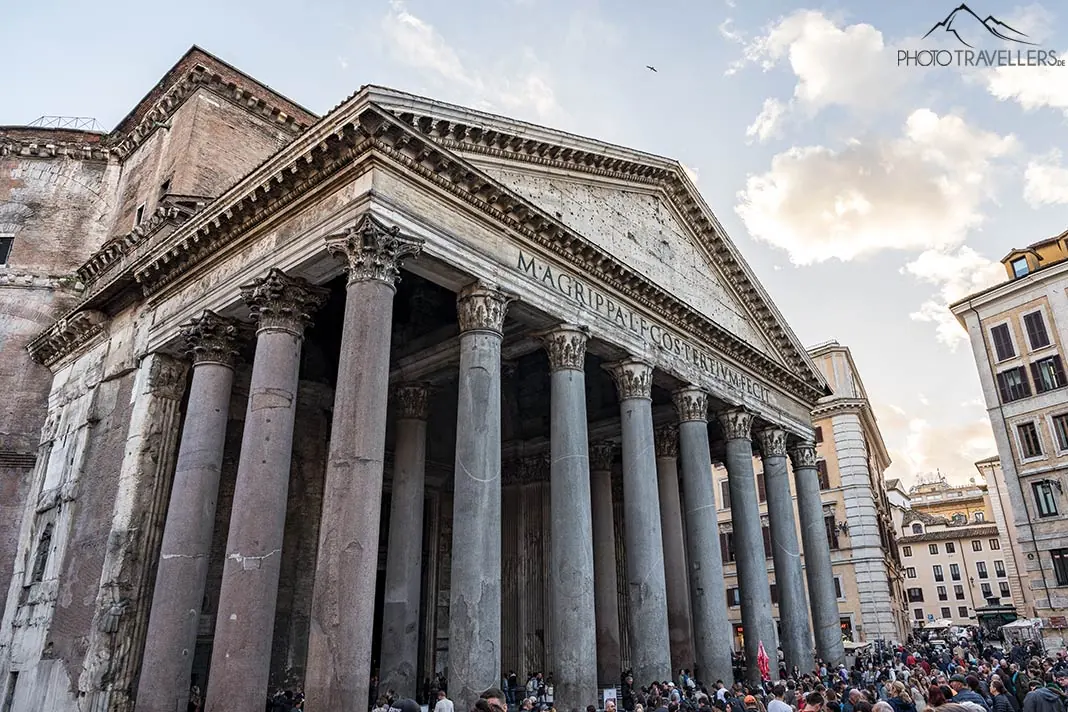 The Pantheon is one of the most visited sights in the city
The Pantheon is one of the most visited sights in the city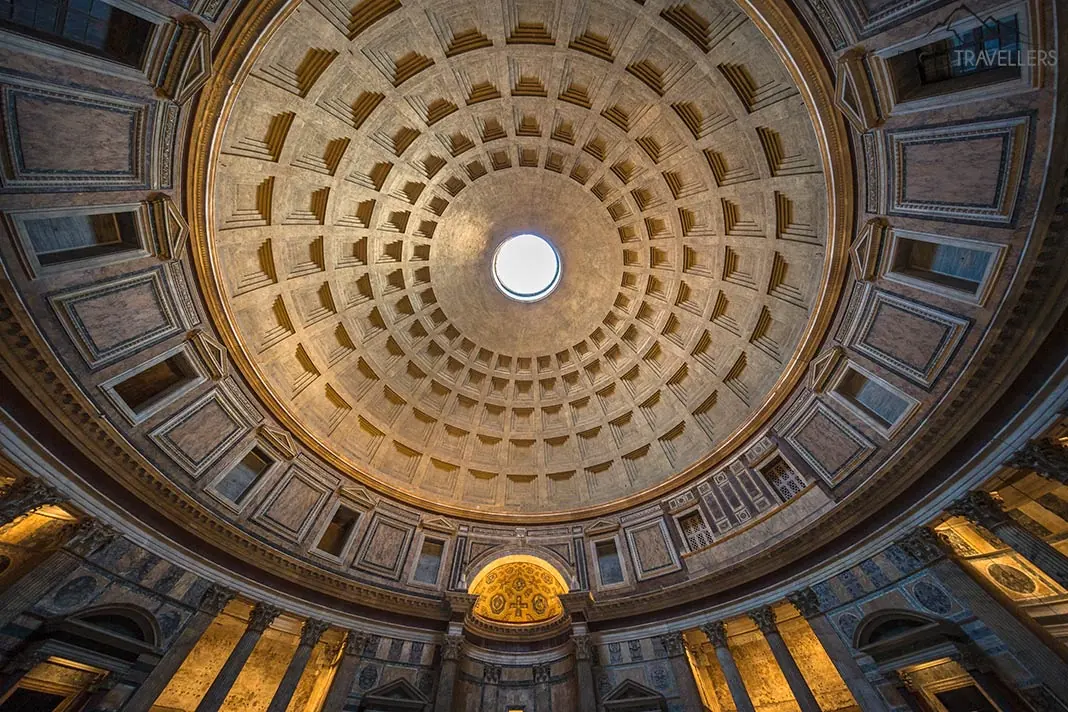 You simply have to see this dome
You simply have to see this domeThe Pantheon (La Rotonda) is just a few minutes away from the Trevi Fountain. The Pantheon dates back to the first century AD and is one of the best-preserved buildings of Roman antiquity. Once dedicated to the gods of Rome, it was rededicated as a Roman Catholic church (Santa Maria ad Martyres) in 609. Among others, the famous painter Raphael is buried here.
The special thing about the Pantheon is that the dome, which is a perfect hemisphere, is actually open at the top. This creates unique lighting effects when the sun shines through the circular hole in the middle of the spectacular building. But when it rains, it also rains inside the building. The dome was also the largest dome in the world for more than 1700 years, based on the inner diameter of 43.44 meters.
Admission to the Pantheon costs five euros. The queues at the tills are sometimes very long. However, you can buy the ticket spontaneously on the Internet. Unfortunately, the procedure is a little complicated, but it will save you a lot of time!
8. Piazza Navona

Piazza Navona is one of the most beautiful squares in Rome
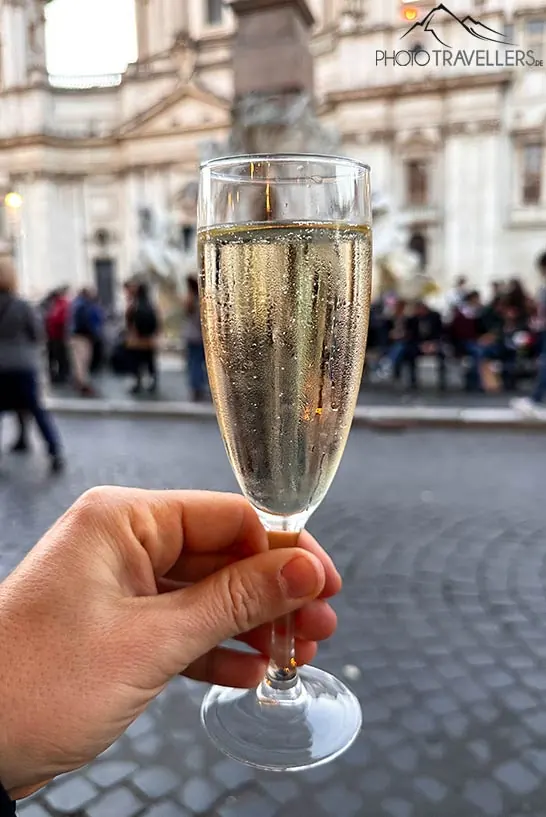
There are some good restaurants on the square
Piazza Navona, one of the most beautiful squares in Rome, is very close to the Pantheon. The square has existed since ancient times. In ancient times, the square was used as a stadium for the athletic competitions that originated in Greece and were called Agon – hence the oval shape of the square. The name later became “in Agone”, then “n’ Agone” and finally Navona.
The original name can still be found today in the baroque church of Sant’Agnese in Agone, which is located on the west side of the square. There are also Here, too, there is an obelisk in the middle of a baroque marble fountain.
The magnificent four-stream fountain shows four male figures, each symbolize one of four rivers: Danube, Ganges, Nile and Río de la Plata. They in turn stand for each of the four known 17th century Continents.
There are also two older but smaller fountains in Piazza Navona: the Neptune Fountain in the north and the Fontana del Moro in the south. Other churches and palaces, as well as tourist cafés and souvenir stores line the beautiful square in the heart of Rome.
9. Villa Borghese with Galleria Borghese
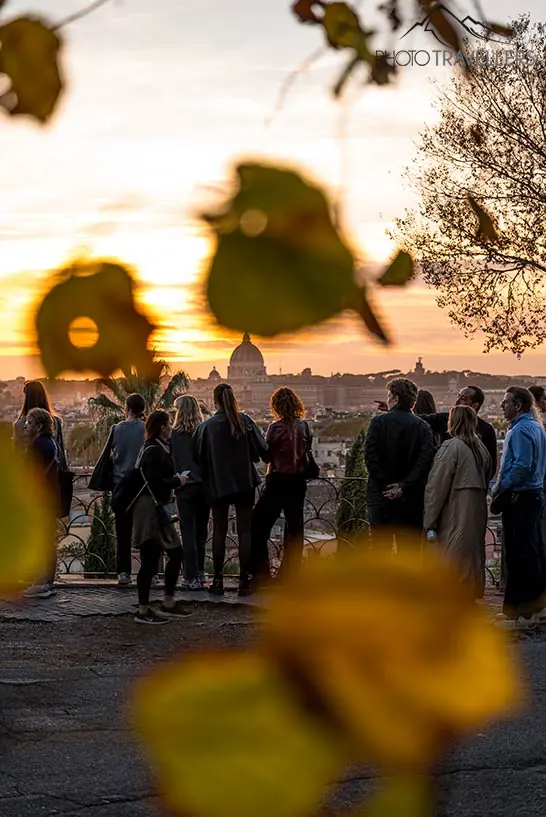 There’s always a lot going on at Terrazza Viale del Belvedere in the evening
There’s always a lot going on at Terrazza Viale del Belvedere in the evening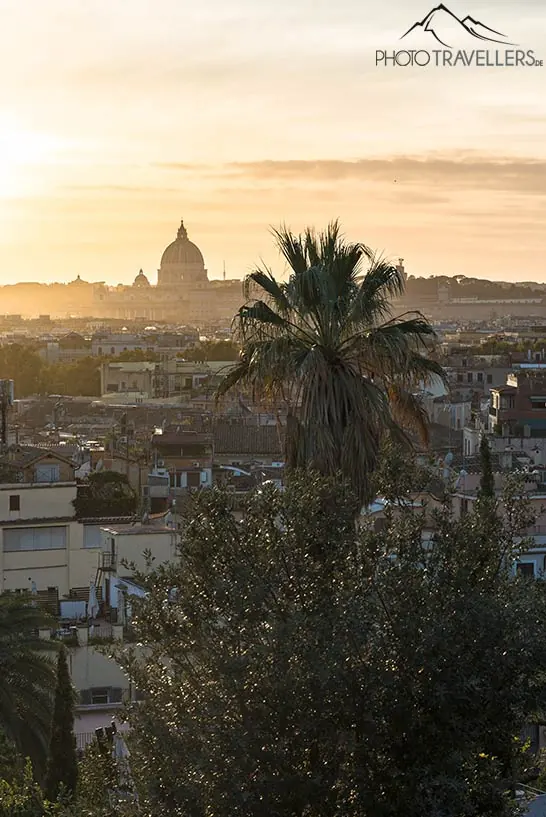 This great view awaits you from the terrace
This great view awaits you from the terrace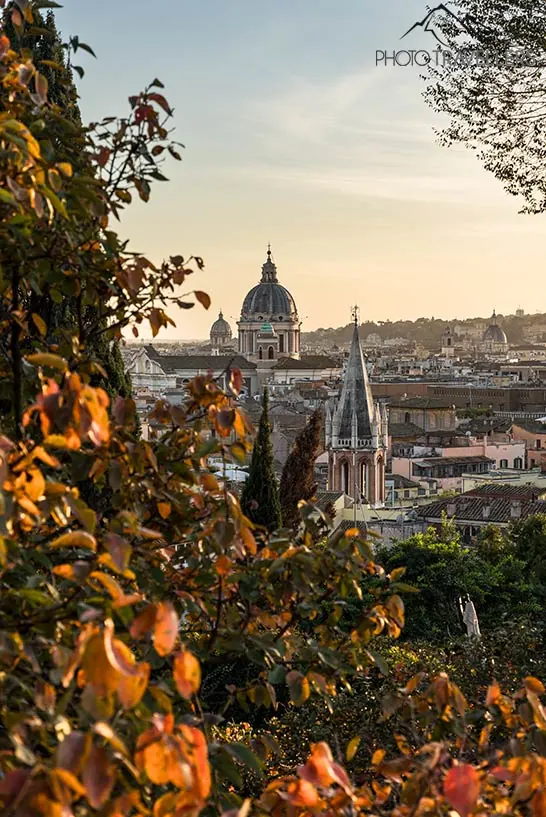 Just a few meters further on we discovered this beautiful photo spot
Just a few meters further on we discovered this beautiful photo spotOur next highlight is the Villa Borghese, a huge park in the middle of the city. The name goes back to an old Roman noble family. Villa Borghese used to be home to vineyards, gardens, stables and a zoo, as well as large art collections.
The casino is still a well-known attraction today. This is not an amusement arcade, but a magnificent castle. The former summer residence of the Borgheses houses the impressive Galleria Borghese (Museo e Galleria Borghese), an art museum with numerous valuable works of art.
There is also a famous small lake with the Temple of Asclepius and a zoo on the approximately five square kilometer grounds of Villa Borghese. Various viewpoints are also part of the ensemble. Probably the best known is the Terrazza del Pincio (Google Maps). From here you have an excellent view over the city and the Piazza del Popolo, our next point of interest.
But we find the Terrazza Viale del Belvedere (Google Maps), not far from the Spanish Steps, even more beautiful. The view from up here in the evening is simply breathtaking.
The best way to explore the huge city park is to rent a bike (you can hire one in the park) or book a tour with one of the golf carts.
10. Piazza del Popolo
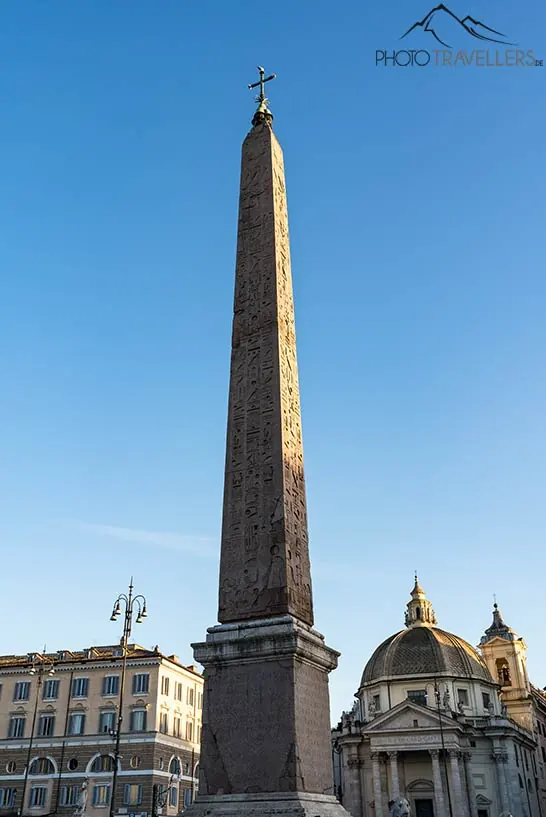
The Obelisco Flaminio stands in the middle of the beautiful square
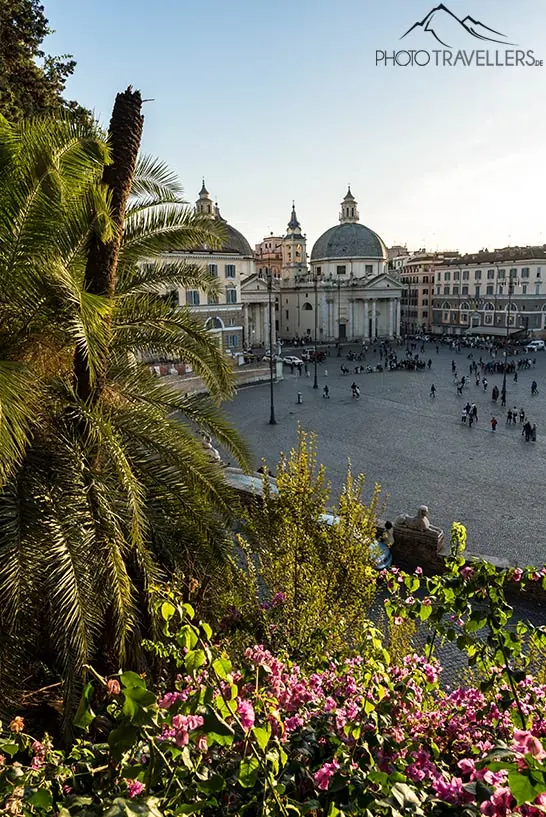
This is the view from the Terrazza del Pincio to the Piazza del Popolo
Piazza del Popolo is located directly below the aforementioned Terrazza del Pincio. The well-known “People’s Square” was the central northern entrance to the city in ancient times. On the square stands the mighty Obelisco Flaminio, the second oldest and second largest Egyptian obelisk in Rome.
You will also find the Porta del Popolo and the church of Santa Maria del Popolo with the adjoining Augustinian monastery. At the southern end of the square are the famous twin churches of Santa Maria in Montesanto and Santa Maria dei Miracoli from the 17th century.
The three main streets Via del Corso, Via del Babuino and Via di Ripetta branch off from the piazza. This cross is therefore often referred to as a tridente or trident.
11. Castel Sant’Angelo
Another well-known sight is Castel Sant’Angelo. Originally built as a mausoleum for the Roman Emperor Hadrian, Castel Sant’Angelo now houses a museum with a viewing platform.
In the meantime, Castel Sant’Angelo served as a papal refuge and prison, among other things. Incidentally, the name comes from the fact that the archangel Michael supposedly appeared above the castle and announced the end of the plague. This is why his bronze figure still adorns the top of the building today.
The Angels’ Bridge, which leads directly to the castle, is also worth seeing with its ten baroque angel figures. Especially in the evening, when everything is illuminated, a magical sight awaits you.
Illuminati fans will be familiar with Castel Sant’Angelo: In Dan Brown’s novel, it was once the meeting place of the secret society.
12. Victor Emanuel Monument
 The Victor Emmanuel Monument is a must on any trip to Rome
The Victor Emmanuel Monument is a must on any trip to Rome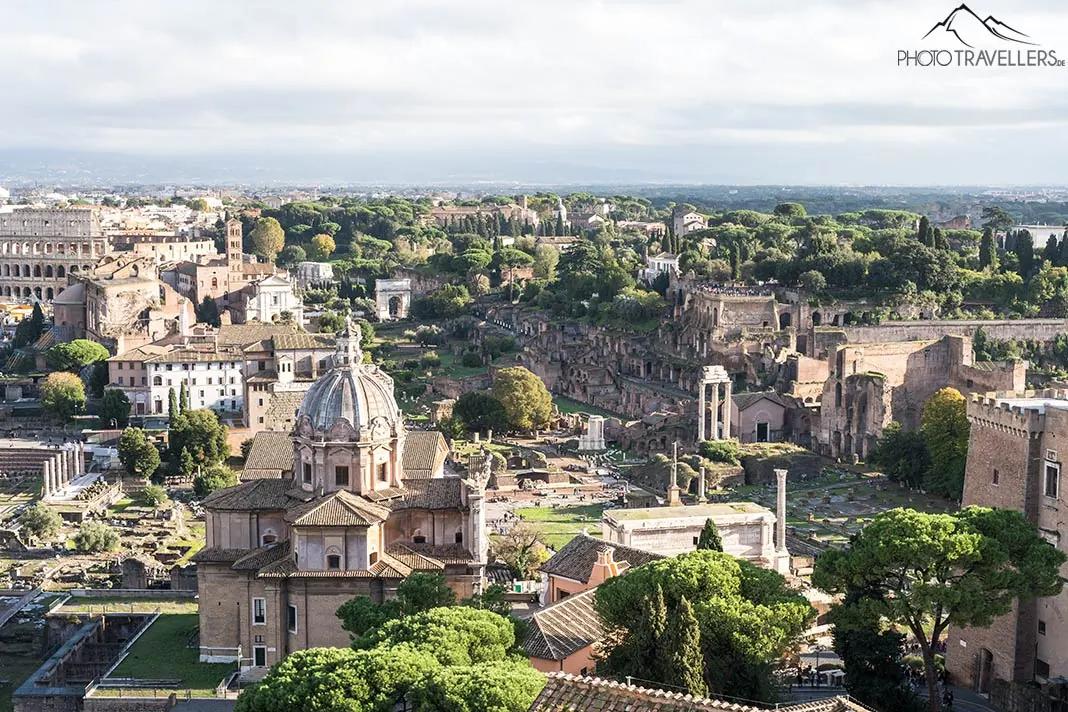 This is the magnificent view of the Roman Forum with the Colosseum from the Victor Emmanuel Monument
This is the magnificent view of the Roman Forum with the Colosseum from the Victor Emmanuel MonumentDefinitely worth a visit is the huge Victor Emmanuel Monument (Monumento a Vittorio Emanuele II), also known as the typewriter due to its design. The colossal white marble building was built in 1885 as a monument to the first king of the newly founded Kingdom of Italy, Victor Emmanuel II.
He is also the one you can admire on a horse in front of the typewriter. The huge equestrian statue is no less than 12 meters high – a grown man, for example, can easily stand upright in the horse’s belly alone! As with many national monuments, there is also a tomb of the unknown soldier and the “Altar of the Fatherland” with an eternal flame, which is guarded day and night by two soldiers.
The building itself houses, among other things, the Museo del Risorgimento, which commemorates the Italian state-founding movement in the 19th century. You can also enjoy a magnificent panoramic view from a height of 80 meters from the Terrazza delle Quadrighe viewing platform (admission 16 euros).
13. Trajan’s Column
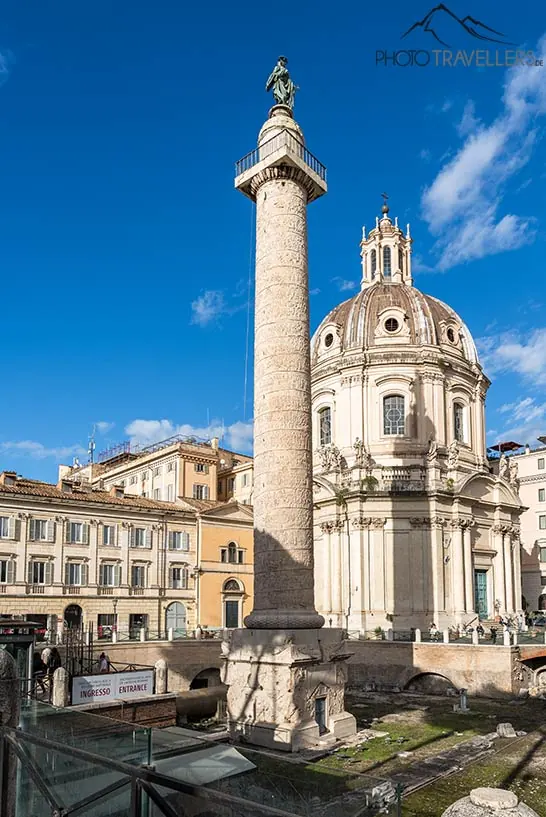
Trajan’s Column with the Chiesa del Santissimo Nome di Maria al Foro Traiano
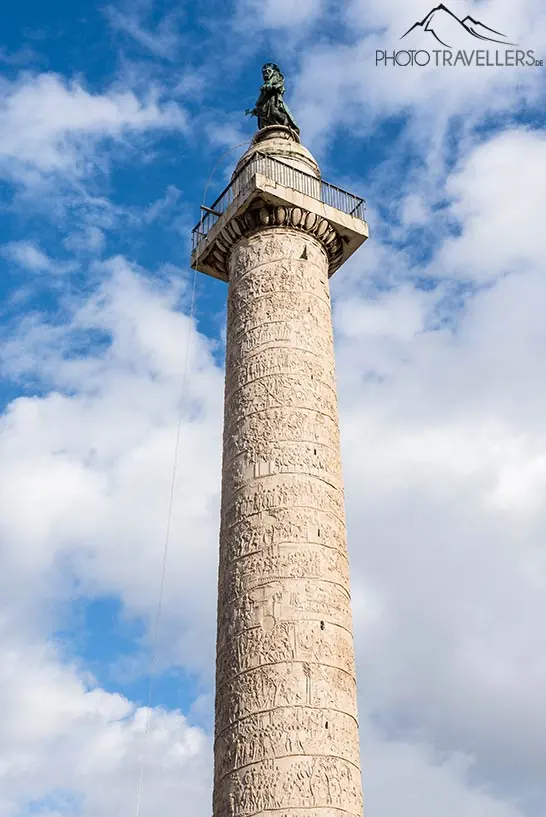
Many exciting details can be seen on the column
Very close to the Victor Emanuel Monument and the Roman Forum, Trajan’s Column (Colonna Traiana), erected on this site in 113, rises 30 meters into the sky. The Column of Honor is the impressive highlight of the relatively well-preserved Trajan’s Forum.
The numerous, extremely detailed decorations are well worth seeing. A total of around 2,500 human figures, each around 60-75 centimeters high, adorn Trajan’s Column. For example, you can learn a lot about clothing and weapons in the 2nd century from the depictions.
In the hollow interior of the column, a spiral staircase leads to the viewing platform, which is no longer accessible today and from which you had a great view over Rome in ancient times. There was originally a gilded statue of Emperor Trajan at the top, but in the 16th century the Pope replaced it with a statue of St. Peter the Apostle, which you can still see there today.
Tip: The Column of Marcus Aurelius (Colonna di Marco Aurelio) in the city center (Google Maps) was built according to the model of Trajan’s Column – around 80 years later than the latter.
14. Aventine with Giardino degli Aranci and keyhole
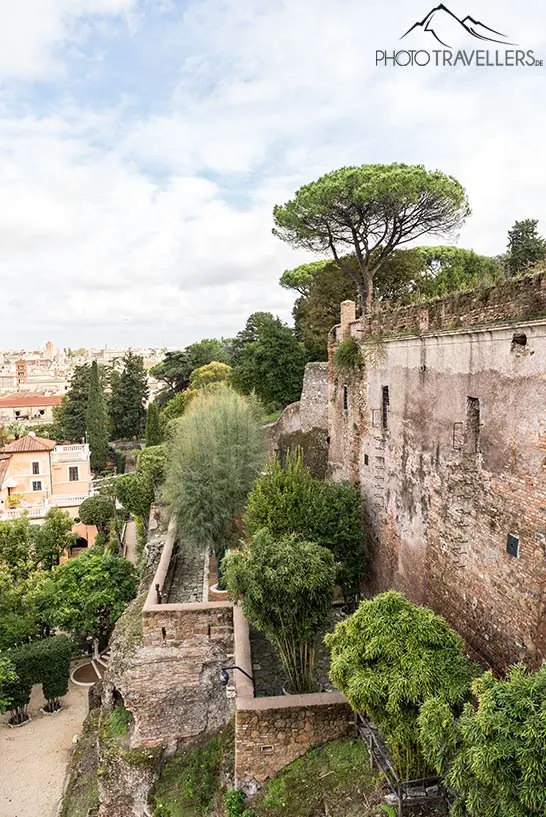 For us, the Aventine panoramic terrace is one of the most beautiful places in the city
For us, the Aventine panoramic terrace is one of the most beautiful places in the city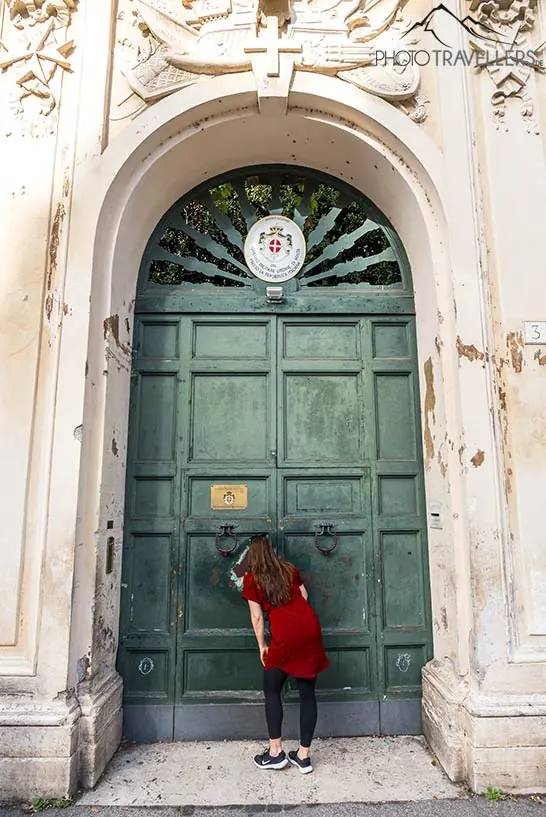 Here Biggi looks through the “keyhole”
Here Biggi looks through the “keyhole”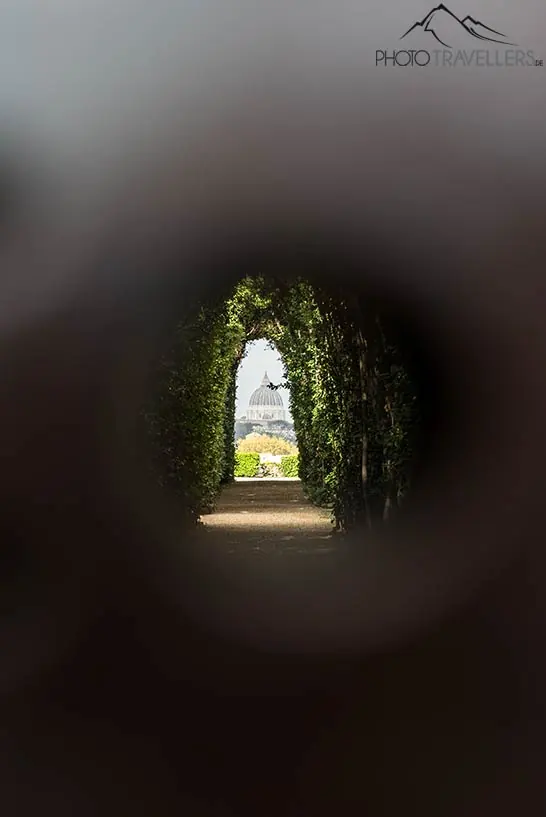 And this is the view of St. Peter’s Basilica through the peephole
And this is the view of St. Peter’s Basilica through the peepholeOur next highlight is the Savello Park, known as the Giardino degli Aranci (Orange Garden), on the Aventine. This is the southernmost of the seven hills.
It’s quite a climb, but the view from the viewing terrace is worth it! Of course, this spot is no longer an insider tip and you will have to share the panorama of Rome at sunset with lots of people. Be sure to visit the imposing Basilica di Santa Sabina all’Aventino, a beautiful church from the 5th century.
The famous Aventine keyhole (Google Maps) is also a must-see. At first glance, there is nothing special about the Piazza dei Cavalieri di Malta. But then there is this green door, in front of which long queues regularly form. A peephole (not a real keyhole, by the way) has been built into the door, through which you have an extraordinary view of St. Peter’s Basilica. It’s best to be here very early in the morning – otherwise you’ll be waiting an hour or more just to look through the hole for a few seconds.
Photo tip: To photograph St. Peter’s Basilica through the Aventine peephole, it is best to use a camera with an interchangeable lens and a fairly long focal length. The best pictures are taken in manual mode with manual focus. By the way, you can access our online photo course here.
15. Circus Maximus
The Circus Maximus (Circo Massimo) was the largest arena in ancient Rome, where mainly chariot races were held, but also gladiator fights and animal hunts. Today, only the green area and some excavations of the stands give an idea of how spectacular this place must once have been. Nevertheless, we liked the place very much and can only recommend a detour.
Up to 250,000 people are said to have flocked to the arena for the chariot races. Gigantic, isn’t it?
16. Bocca de la Verità
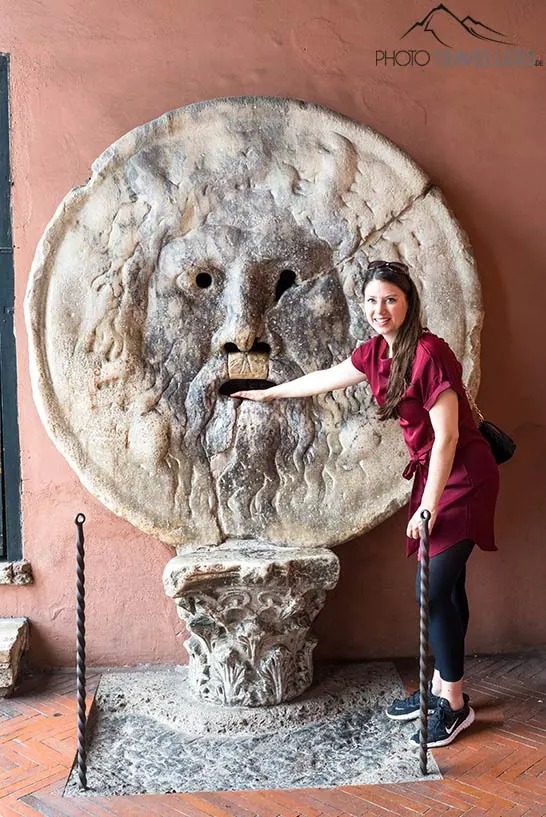
I wonder if the mouth of the Bocca de la Verità has closed?

A look into the crypt of the church is worthwhile
Another tip is the Bocca de la Verità, a man’s face carved on an ancient manhole cover in front of the Basilica di Santa Maria in Cosmedin. There are numerous legends surrounding the “Mouth of Truth”. If you put your hand in the mouth of the stone face, it should close when you lie.
Today, every visitor to Rome wants to put their hand in the Roman lie detector. There are often long queues here.
It is also worth taking a look inside the church. Our highlight here is the small crypt in the cellar. Admission is free, but a donation is requested.
17. Trastevere
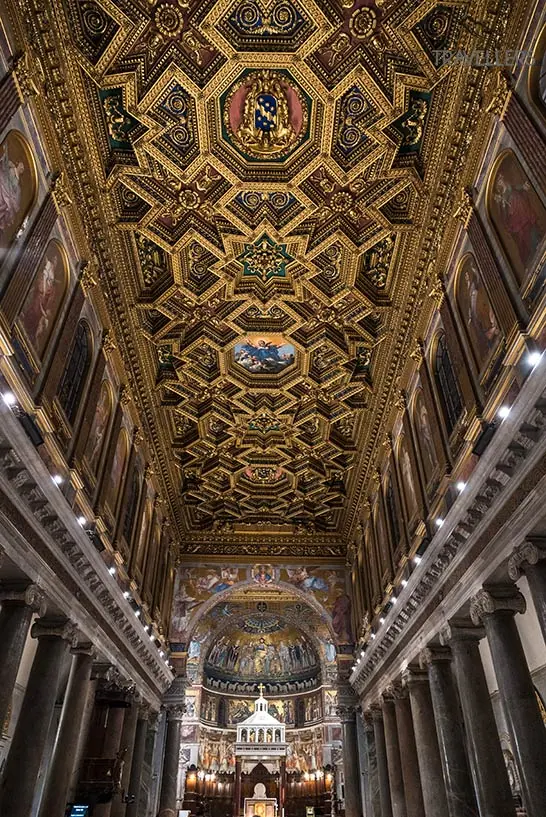 The Basilica di Santa Maria in Trastevere is an architectural highlight in the beautiful Trastevere district
The Basilica di Santa Maria in Trastevere is an architectural highlight in the beautiful Trastevere district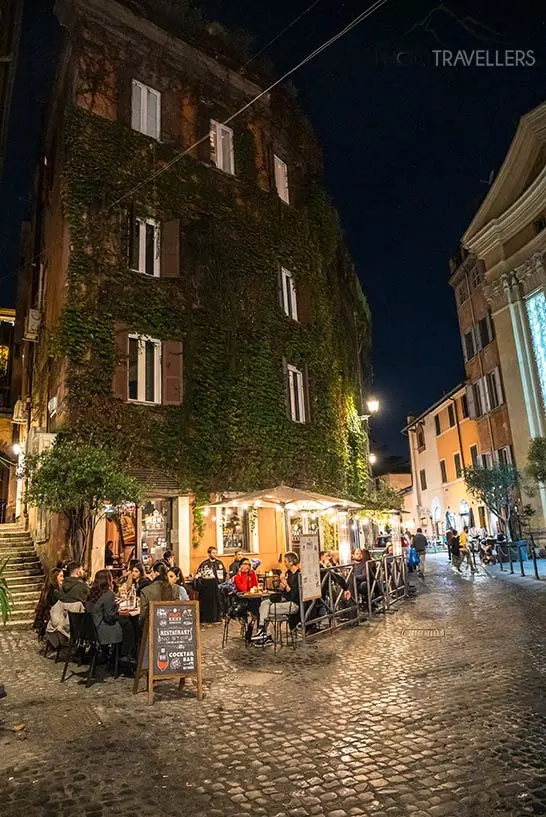 There is a bar or restaurant on every corner in Trastevere
There is a bar or restaurant on every corner in Trastevere Here we enjoyed some tonnarelli at Tonnarello
Here we enjoyed some tonnarelli at TonnarelloRome is also known for its many cafés, bars and restaurants. One of the most beautiful nightlife districts is Trastevere, which translates as “on the other side of the Tiber”. One photo opportunity follows the next. There is something to discover on every corner.
The magnificent Basilica di Santa Maria in Trastevere is the focal point of the ancient quarter. It’s worth taking a look inside the huge church!
Otherwise, the motto in Trastevere is: just let yourself drift through the beautiful cobbled streets and enjoy the flair.
In Trastevere, on Via della Paglia, you will also find the Tonnarello, one of the city’s most famous restaurants. Of course we tried the tonnarelli, a long pasta like spaghetti but much thicker. We were thrilled!
Here you can find our restaurant tips for Rome.
18. Campo de’ Fiori
The Campo de’ Fiori on the Campo de’ Fiori, very close to the aforementioned Piazza Navona, is also well worth a visit.
Apart from Sunday, there is a lovely market here every day with flowers and food, and the square is also a popular meeting place in the city in the evening thanks to the surrounding bars.
19. Crypt of the Capuchins
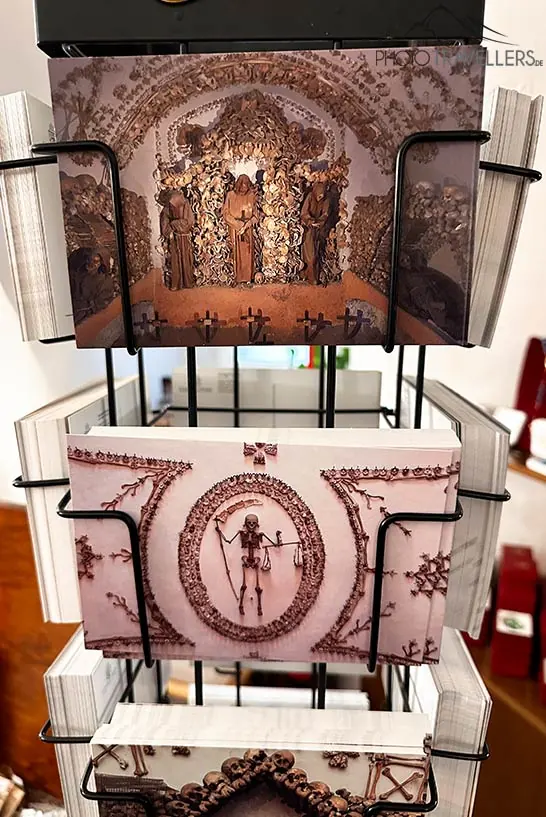
The Crypt of the Capuchins (Museo e Cripta dei Frati Cappuccini) is almost an insider tip. A museum with all kinds of information about the Capuchin order and a crypt with artfully arranged human skulls and bones await you.
Goosebumps are guaranteed in this very special place!
20. Basilica di Santa Maria Maggiore
There are plenty of churches in Rome. We have already introduced you to some beautiful places of worship. Last but not least, let’s throw the imposing Basilica di Santa Maria Maggiore into the ring.
The papal basilica dates back to the 5th century and is known for its Roman mosaics and gilded ceiling. If you are interested in church art, a visit to the church, very close to the main station, is a must.
Extra tip: Catacombs of St. Callistus and Via Appia
There are more than 60 catacombs in Rome. The best known are the Catacombs of St. Callistus (website). They are located near the ancient Via Appia (Google Maps), which was laid out as early as 312 BC and served as the main thoroughfare. Today, for example, you can take a bike tour* along the old route.
Eating and drinking in Rome
There is no shortage of restaurants, bars and cafés in Rome. You’ll find a great restaurant on almost every corner. The typical tourist traps that we know from other cities hardly exist in Rome. Most of the restaurants can be recommended blindly.
For inspiration, you can find our tips on eating and drinking in Rome here.
Where to stay in Rome: our hotel tips
In addition to luxurious furnishings and an excellent location in the immediate vicinity of Piazza Navona, the 5-star Bio Hotel Raphael – Relais & Châteaux (check prices*) has its own rooftop bar with breathtaking views over Rome.
However, the 3-star Hotel Smeraldo (check prices*) also has all this to offer. The Hotel Paolo II (check prices) also has 3 stars and is located right next to the Vatican. Nevertheless, guests praise the quiet location of this first-class accommodation.
If you prefer to have an entire vacation apartment to yourself, you should pay particular attention to the next three tips. The Core de Roma apartment (check prices*) with 60 m² is also close to Piazza Navona, while the somewhat larger Casa Cimini (check prices*), furnished in a country house style, is located further south towards the Orange Garden.
On the other side of the river, you will find the Unforgettable Trastevere vacation apartment in the picturesque Trastevere district (check prices*). It is beautifully furnished with great attention to detail and even has a lush balcony.
Journey to Rome
Most tourists arrive by plane and land at Rome-Fiumicino Airport or the smaller Rome-Ciampino Airport.
From Fiumicino, you can reach the city center in around 30 minutes by train (18 euros). The cheaper shuttle buses (around 12 euros) take 40 to 60 minutes. The cab costs a flat rate of 48 euros.
An alternative to the plane is the train. The ÖBB Nightjet, for example, departs daily in the evening from Munich and arrives in Rome in the morning. So you still have the whole day available for sightseeing.
Map with all the sights in Rome
You can find an overview of the most beautiful sights in Rome on our interactive map:
[mapsmarker map=”318″]
So there you have it, the most beautiful sights in Rome. Do you have any suggestions or further ideas? Let us know in the comments – we’d love to hear from you!
